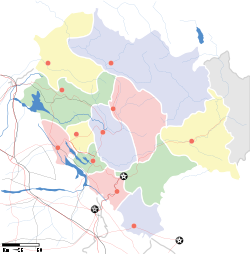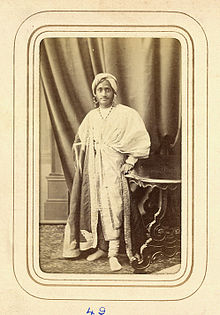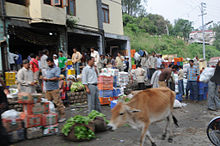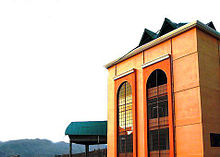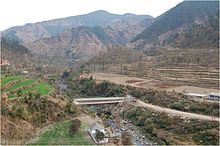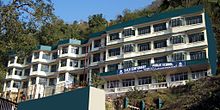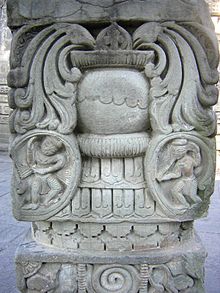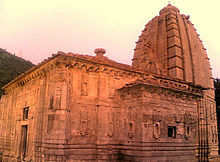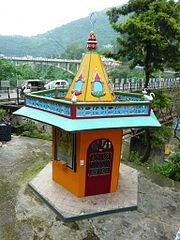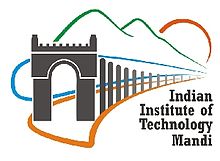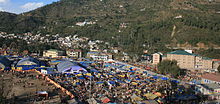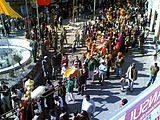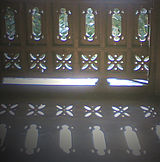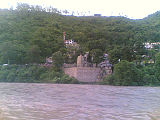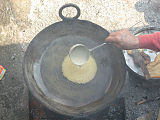- Mandi, Himachal Pradesh
-
For other uses, see Mandi (disambiguation).
Mandi
मंडी
Choti Kashi, Varanasi Of Hills — city — Indira Market showing Ghanta Ghar right at the centre of city Coordinates 31°42′25″N 76°55′54″E / 31.70694°N 76.93167°ECoordinates: 31°42′25″N 76°55′54″E / 31.70694°N 76.93167°E Former name Mandav Nagar Country India State Himachal Pradesh District(s) Mandi † Deputy Commissioner Sh. Devesh Kumar, IAS Superintendent of police Sh. Pupul Dutta Prasad, IPS Founded| Ajbar Sen in 1527 Population
• Density
56,873(2nd)[1] (2005[update])
• 5,446 /km2 (14,105 /sq mi)
Sex ratio 1000/1013(2nd) ♂/♀ Spoken languages Ethnic groups - Mandyali
- Himachali
- Pahari
- Others
Time zone IST (UTC+05:30) Area
23 km2 (9 sq mi)
• 1,044 metres (3,425 ft)
Climate
• Precipitation
Temperature
• Summer
• WinterCw (Köppen)
• 1,380 mm (54 in)
• 23 °C (73 °F)
• 29 °C (84 °F)
• 17 °C (63 °F)Footnotes- † The Mandi Planning area also includes some portions of Mandi District.
Website Official website of Mandi Mandi (
 /ˈmaʊndi/; Hindi: मंडी or मण्डी,Punjabi: ਮੰਦੀ, Mandi, IPA: /Mandi/ (
/ˈmaʊndi/; Hindi: मंडी or मण्डी,Punjabi: ਮੰਦੀ, Mandi, IPA: /Mandi/ ( listen), formerly known as Mandav Nagar, also known as Sahor (Tibetan: Zahor),officially Head Quarters of District Mandi and Zonal Headquarter of central zone including Districts namely Kullu, Bilaspur, and Hamirpur, is a city and a municipal council in Mandi district in the Indian state of Himachal Pradesh. Mandi is the second-largest by population in state, next to Shimla. Mandi is having second highest sex ratio of 1013 females per thousand males. As a tourist place, Mandi is often referred to as " Varanasi of Hills " or "Choti Kashi" or "Kashi of Himachal". People of Mandi, proudly boast that while Benaras(Kashi) has only 80 temples, Mandi has 81!
listen), formerly known as Mandav Nagar, also known as Sahor (Tibetan: Zahor),officially Head Quarters of District Mandi and Zonal Headquarter of central zone including Districts namely Kullu, Bilaspur, and Hamirpur, is a city and a municipal council in Mandi district in the Indian state of Himachal Pradesh. Mandi is the second-largest by population in state, next to Shimla. Mandi is having second highest sex ratio of 1013 females per thousand males. As a tourist place, Mandi is often referred to as " Varanasi of Hills " or "Choti Kashi" or "Kashi of Himachal". People of Mandi, proudly boast that while Benaras(Kashi) has only 80 temples, Mandi has 81!This one time capital of the princely state of Mandi is a fast developing city that still retains much of its original charm and character. It is situated 145 kilometres (90 mi) north of state capital, Shimla. The total area of the city is 23 km2. The city was established in 1527 by Ajbar Sen,[3] as the seat of the Mandi State, a princely state till 1948. Foundation of the city was laid on the establishment of Himachal Pradesh in early 1948. Main City was shifted from Old Mandi(Purani Mandi) to New Mandi.
Today, it is widely known for the International Mandi Shivaratri Fair. Located in the north-west Himalayas at an average altitude of 1044 metres (3,425 ft), the city of Mandi, experiences pleasant summers and cold winters. The city also has the remains of old palaces and notable examples of ‘colonial’ architecture. The city had one of the oldest buildings of Himachal Pradesh.
Mandi is connected to the Pathankot through National Highway 20 which is almost 220 km(140 mi) long and to Manali and Chandigarh through National Highway 21 which is 323 km(201 mi) long. Mandi is approximately 184.6 km (114.7 mi) from Chandigarh, the nearest major city, and 440.9 km (273.9 mi) from New Delhi, the national capital.
The city is named after the Great Sage Rishi 'Mandav' who prayed in this area, and the rocks turned black due to the severity of his penance, so the city was referred to as Mandvya Nagari in his honour which later came to be know as Mandi.
Etymology
Mandi is renowned for its 81 ancient old stone Shaivite temples [4] and their enormous range of fine carving. Because of this, it is often called the "Varanasi of the Hills". Other authors believe that the name 'Mandi,' is simply derived from the common word mandi which means "market" in Hindi "and it may possibly be connected with the Sanskrit root mandaptika, meaning "an open hall or shed,". Until the mid 20th century, Mandi was on the trade route between Yarkant County and Ladakh to Hoshiarpur and the Indian plains, served as commercial hub and trade centre.[5]
History
The present District of Mandi was formed with the merger of two princely states Mandi State and Suket on the 15th April 1948, when the State of Himachal Pradesh was established.[6]
Important Historical Events
Princely state of Mandi was founded by Bahu Sen in 1200 A.D. But Ajbar Sen was the one who founded Historical city of Mandi in 1526 A.D. The present District of Mandi was formed with the merger of two princely states Mandi State and Suket(Sundernagar) on the 15th April 1948, when the State of Himachal Pradesh was established. Ajbar Sen assassinated Mandi, it led to beginning of modern period of Mandi history. Old Mandi capital was abandoned & the site of present capital was acquired. Some historians put the selection of present capital in the year 1527 A.D. The idol of Madho Rai, the presiding deity of Mandi and incarnation of Lord Vishnu is said to be made by Goldsmith Bhima, in 1648. Maharaja Ranjit Singh occupied Mandi in 1839 but Ranjit Singh died on 27 June 1839.
It was beginning of disintegration of Sikh powers in the hills and british power emerged as most powerful.In 1849, Princely states of Mandi, Suket and Chamba were put under the control of Superintendent 'Cis-Satluj States'. Lala Lajpat Rai visited Mandi during 1906 to organize the revolutionary activities. Revolt occurred in Mandi State against the repressive, corrupt and arrogant administration of raja Bhawani Sen and his Wazir Jiwa Nand Paddha. This revolt was led by Shobha Ram in 1909. A Prominent revolutionary of Mandi, Hardev Ram joined revolutionary band of patriots in 1913. He went to Shanghai, America and Japan where he met Lala Hardayal and Dr. Mathura Singh. Another revolutionary of Mandi Bhai Hirda Ram started participating in revolutionary activities in 1914. He joined Ras Behari Bose, Mathura Singh, Kartar Singh Sarba, Bhai Parma Nand and Pingle. In 1915, on the request of Sarla Devi, wife of Bhai Hirda Ram, the Viceroy converted his Death sentence into life imprisonment. In the same year, Nagchala Dacoity in Mandi state took place. In Mandi conspiracy case, Mandi revolutionary Sidhu Kharara was sentenced for 7 years in 1917. Mandi Legislative Council was constituted in 1933. Swami Purna Nand of Mandi was elected as president of "Himalayan Hill states regional Council"( founded in 1945) & Pt. Padam Dev became its general secretary. The session of " Himalayan Hill states regional Council" was held at Mandi from March 8,1946 to March 10,1946. It was also attended by INA activists Dhillon, Sehgal and Shahnawaj. So finally ,Mandi came into existence on April 15th,1948. Do you Know that Suraj Sen ruled over Mandi at time of Damdama Mahal of Mandi.
Pre-Independence
The Chiefs of Mandi State are said to be the descendants of common ancestors of the Chandervanshi line of rajputs of Sen dynasty of Bengal who claim to be the descendents of Pandavas of Mahabharata times. According to the earlier accounts, Bahu Sen established an independent territory and was recognized as a Rana or local Chief. The Raja Ajber Sen, the nineteenth descendent from Bahu Sen, was considered as an able and benevolent ruler. He founded the present Mandi city around the ‘Bhootnath Temple’ in early 16th century (1500 AD-1534 AD) and shifted his capital to this place from Purani Mandi. The temple of Trilokinath was also constructed during his reign. He was succeeded by Chhattar Sen who built a fort in Kalar by name Lakargarh. The successive rulers of Mandi were Shyam Sen, Gaur Sen, Sidh Sen, Shamsher Sen, Surma Sen, Ishwari Sen, Jalam Sen, Balbir Sen and Vijay Sen. Many public utility, services and facilities like schools, hospitals and post offices etc. were started by Raja Vijay Sen during his time. He also built large number of palaces and houses. A Mule road from Baijnath in District Kangra to Sultanpur in adjoining District of Kullu, via Mandi and the Victoria suspension Bridge on river Beas were constructed during his time in the year 1877. Raja Vijay Sen was issue less and left no direct heir.
So in 1897, Bhawani Sen was recognized as his successor. During his period the city was considerably damaged in the earthquake of 1905. He was succeeded by Joginder Sen in April 1914 who was, however, vested with full powers of ruling chief in February 1925. During the period of his minority, Mandi remained under the management of a British Officer and a number of Departments were overhauled and re-organised. Mandi being one of the oldest city is enjoying urban status since 1901. The Mandi palace popularly known as “Raj Mahal” as it looked in the past. The area where fascinating “Sunkan Garden” exists today was once a pond.
Predecessors and Short History
The predecessor state of Siokot was founded in 1527. Formerly part of the Kingdom of Suket in the Punjab Hills, the dynasty traditionally goes back to 765AD. In about 1100, Vijaya Sen had two sons, Sahu Sen who ruled over Suket and Bahu Sen who ruled over Kullu. Bahu Sen’s descendants emigrated to Kullu until the tenth descendant, Kabakha Sen was killed by the Raja of Kullu and his son had to flee to Siokot, not very far from the present city of Mandi which was founded during Ajbar Sen’s rule. Rulers were....
- Raja BAHU SEN, 1st Raja of Siokot, younger son of Raja Vijai Sen of Suket.
- Raja NIM SEN, 2nd Raja of Siokot
- Raja NIRHABAT SEN, 3rd Raja of Siokot
- Raja KAHABAT SEN, 4th Raja of Siokot
- Raja SAMMAT SEN, 5th Raja of Siokot
- Raja BIR SEN, 6th Raja of Siokot
- Raja SAMUDRA SEN, 7th Raja of Siokot
- Raja KESAB SEN, 8th Raja of Siokot
- Raja MALAB SEN, 9th Raja of Siokot
- Raja JAI SEN, 10th Raja of Siokot
- Raja KRANCHAN SEN, 11th Raja of Siokot 1278/1301, he was the first Raja to overthrow the authority of the Raja of Kullu; married the daughter of the Raja of Siokot and had issue. He was killed by the Raja of Kullu in 1301.
- Raja BAN SEN, 12th Raja of Siokot 1301/1346, born posthumously in 1301, he was adopted by his maternal grandfather, married and had issue.
- Raja KALIAN SEN, 13th Raja of Siokot 1300/1332 or 1346/1387, married and had issue.
- Raja HIRA SEN, 14th Raja of Siokot 1332/1360 or 1387/1405, married and had issue.
- Raja DHARITRI SEN, 15th Raja of Siokot 1360/- or 1405/1425
- Raja NARINDAR SEN, 16th Raja of Siokot 400/- or 1425/1425
- Raja PRAJAR SEN, 17th Raja of Siokot 1440/- or 1425/1470
- Raja DILAWAR SEN, 18th Raja of Siokot 1470/1499, died 1499.
- Raja AJBAR SEN, 19th Raja of Siokot 1499/1527
1st Raja of Mandi 1527/1534, initially 19th Rana of Siokot from 1499, he founded the Mandi in 1527 and became the first Raja of Mandi, married and had issue. He died 1534.
- Raja CHHATAR SEN, 2nd Raja of Mandi 1534/1554, married and had issue.
- Raja SAHIB SEN, 3rd Raja of Mandi 1554/1575 or 1534/1554, married Rani Prakash Devi, daughter of the Raja of Bilaspur, and had issue.
- Raja NARAIN SEN, 4th Raja of Mandi 1575/1595 or 1554/1574
- Raja KESHAB SEN, 5th Raja of Mandi 1595/1616 or 1574/1604, married and had issue.
- Raja HARI SEN, 6th Raja of Mandi 1616/1637 or 1604/1637, married and had issue. He died 1637 or 1623.
- Raja SURAJ SEN, 7th Raja of Mandi 1637/1664 or 1623/1658, married (amongst others), a daughter of Raja Jagat Singh of Nurpur, and had issue. He died March 1664.
Kumari (name unknown), married 1658
- Raja SHYAM SEN, 8th Raja of Mandi 1664/1679 or 1658/1673, married and had issue. He died in 1673 (or 1679), when five Ranis, two concubines and 37 slave girls committed sati.
- Raja GAUR SEN, 9th Raja of Mandi 1679/1684 or 1673/1678, married (amongst others), a daughter of Raja Budhi Chand of Sirmur, and had issue, as well as illegitimate issue. He died 1684.
- Raja SIDHI SEN, 10th Raja of Mandi 1684/1727 or 1678/1719, married and had issue. He died 1727.
Tikka Shiv Jawala Sen, married (amongst others), a daughter of the Rana of Hatli, and had issue. He died in 1703 or 1722.
- Raja Shamsher Sen (by a daughter of the Rana of Hatli)
Raja SHAMSHER SEN, 11th Raja of Mandi 1727/1781, born 1722, married (amongst others), the daughter of Raja Ugar Singh of Chamba, and had issue. He died 1781.
- Raja SURMA SEN, 12th Raja of Mandi 1781/1788, married and had issue, as well as illegitimate issue. He died 1788.
- Raja ISHWARI SEN, 13th Raja of Mandi 1788/1826, born 1784, married 1stly, a daughter of Mian Fateh Chand Katoch, married 2ndly, a daughter of Raja Uggar Singh of Bashahr. He died in 1826.
- Raja ZALIM SEN, 14th Raja of Mandi 1826/1839. He died in June 1839.
- Raja BALBIR SEN, 15th Raja of Mandi 1839/1851, born about 1817, married several wives, and had issue, as well as illegitimate issue. He died 26th January 1851.
- Raja BIJAI SEN, 16th Raja of Mandi 1851/1902, born 1846, ; married 1stly, 21st July 1859, a daughter of Raja Jagat Chand of Datarpur, married 2ndly, 25th July 1859, a daughter of Raja Jai Singh of Guler, married 3rdly, (name unknown), married 4thly, a sister of Mian Kishan Singh Guleria, married 5thly, a daughter of Mian Jagat Singh, married 6thly, a daughter of Mian Hira (or Udham) Chand of Datarpur, and had issue, as well as natural issue. He died 10th December 1902.
- Raja BHAWANI SEN, 17th Raja of Mandi 1902/1912, born 17th April 1883, educated at Aitchison Chiefs College, Lahore; married 1stly, a daughter of Kanwar Balbir Singh of Sirmur, married 2ndly, a daughter of Mian Surat Singh of Suket, married 3trdly, 1907, Rani Lalit Kumari, died 4th May 1938, daughter of Raja Prithvi Dhwaj Shah, Talukdar of Khairigarh-Singhai, and had issue. He died on 9th February 1912.
Interregnum 1912/1913
- Maj. HH Raja Sir JOGINDER SEN Bahadur, 18th Raja of Mandi 1913/1986, son of Mian Kishan Singh Sahib, born 20th August 1904, educated at Queen Mary's College and Aitchison College, Lahore; Indian Ambassador to Brazil 1952/56; Member of Lok Sabha 1957/62; Honorary Lt.-Col. 3rd/17th Dogra Regiment and Bengal Sappers and Miners, married 1stly, about 1911, a daughter of Thakur Devi Singh of Delath, married 2ndly, 8th February 1923, HH Rani Amrit Kaur, born 1904, died 1948, daughter of Col. HH Farzand i-Dilband Rasikhul-Itiqad Daulat-i-Inglishia Raja-i-Rajgan Maharaja Sir Jagatjit Singh Bahadur of Kapurthala, and his wife, Rani Kanari, married 3rdly, 13th May 1930, Kumari Kusum Kumari [HH Rani Kusum Kumari of Mandi], born 27th August 1913, died June 1998, daughter of Kunwar Prithiraj Sinhji of Rajpipla, and had issue, two sons and two daughters. He died 16th June 1986.
- HH Raja ASHOKPAL SEN, 19th and Current Raja of Mandi(1986-present)
Post Independence
Mandi District was formed by amalgamation of the erstwhile princely states of Mandi and Suket on the formation of Himachal Pradesh on 15th April, 1948. Since then, it is serving as the District headquarter of the Mandi District. Mandi district comprises of 7 Tehsils namely Jogindernagar, Sarkaghat, Sundernagar, Sadar Mandi, Chachyot, Thunag, Karsog and 9 Sub-Tehsils i.e Ladbharol,Padher, Sandhole, Dharmpur, Baldwara, Nihri, Kotti, Aut, Balichowki.
For the purpose of development activities, the District has been divided into 10 Blocks. The District has a total population of 9, 00,987 persons as per 2001 Census and area of 3,950 Sq.Km. and covers 7.10 % area of the State.The District has six cities including Pandoh as census city. These are namely Mandi Sundernagar, Jogindernagar, Rewalsar, Sarkaghat and Pandoh. Recently Mandi has become Zonal Headquarter of Central Zone, which covers the Districts of Bilaspur, Hamirpur, Kullu and Mandi itself and has gained much importance from administrative point of view.
Municipal Council
Nagar Parishad Mandi was constituted during the year of 1950. Presently it has 13 Wards consisting of 10 Revenue Hadbasts. So far as population of Nagar Parishad is concerned, it is the biggest Parishad of the District.
Geography
Mandi is built on the banks of the Beas River, at the confluence of the Suketi Khad stream. Sikandar Dhar, Ghugar Dhar and Dhar Kot are some of the prominent hills and mountains found near the city. Mandi is located in 31o72'N latitude and 76o92'E longitude. It has an average elevation of 1044 metres (3,425 feet). There is great variation in the climatic conditions of Himachal due to extreme variation in elevation. The climate varies from hot and sub-humid tropical in the southern tracts to cold, alpine and glacial in the northern and eastern mountain ranges with more elevation. A bowl shaped table land on the banks of river Beas, the city is surrounded by the high hill ranges of Gandharv Hills, Motipur Dhar, Rehra Dhar and Tarna Hill. Two small rivulets, Suketi Khad and Skodhi Khad join River Beas. Besides, the table land on the banks of river/streams, terrain is steep and hilly. Geologically, the city is located in seismic Zone No. IV near a fault line and is prone to earthquakes. As National Highway-20 Pathankot-Mandi, National Highway-21 Chandigarh-Mandi-Manali, National Highway-70 Hoshiarpur-Mandi and State Highway-32 Hoshiarpur-Mandi passes through city, it is well connected with Jogindernagar, Palampur, Pathankot, Kullu, Sundernagar, Bilaspur, Chandigarh, Rewalsar and Una. Though Mandi is an old and fast developing city yet it still retains its original charm and character.
Climate
Mandi features a subtropical highland climate under the Koppen climate classification.The climate of Mandi is composite having hot summers and cold winters. Mandi city falls in the lower most climatic zone of the Himalayas. These regions enjoys a Wet-sub temperate climate of the foot hills (450-900m) as against the Dry-cold alpine climate with snow fall at higher altitudes (2400- 4800mts). Temperatures typically range from 6.7 °C (44.06 °F) to 39.6 °C (103.28 °F) over the course of a year. The average temperature during summer is between 18.9 °C (66.02 °F) and 39.6 °C (103.28 °F), and between 6.7 °C (44.06 °F) and 26.2 °C (79.16 °F) in winter. Monthly precipitation varies between 25.4 millimetres (1 in) in November to 228.6 millimetres (9 in) in August. It is typically around 58.3 millimetres (2.29 in) per month during winter and spring and around 101.6 millimetres (4 in) in June as the monsoon approaches. The average total annual precipitation is 1,092.2 millimetres (43 in), which is much less than most other hill stations but still greatly heavier than on the plains. Snowfall in the region, which historically has taken place few years ago is now very rare these years due to increasing temperature and global warming.
Climate data for Mandi Month Jan Feb Mar Apr May Jun Jul Aug Sep Oct Nov Dec Year Average high °C (°F) 18.9
(66.0)21.0
(69.8)26.0
(78.8)34.6
(94.3)38.8
(101.8)39.6
(103.3)34.9
(94.8)32.9
(91.2)33.4
(92.1)32.0
(89.6)26.4
(79.5)20.7
(69.3)29.93 Average low °C (°F) 6.7
(44.1)8.5
(47.3)12.8
(55.0)18.8
(65.8)23.3
(73.9)26.2
(79.2)26.1
(79.0)24.8
(76.6)23.4
(74.1)17.7
(63.9)11.6
(52.9)7.4
(45.3)17.27 Precipitation mm (inches) 50.8
(2)76.2
(3)101.6
(4)25.4
(1)50.8
(2)101.6
(4)279.4
(11)228.6
(9)101.6
(4)0
(0)25.4
(1)50.8
(2)1,092.2
(43)Source: yr.no[7] Demographics
Mandi city consists of the municipal council and Mandi planning areas (MPA).As of 2001[update] India census,[8] City had a population of 56,873. Males constitute 53% of the population and females 47%. Mandi has an average literacy rate of 83.5%, higher than the national average of 65.38% & almost equal to state's literacy rate(83.57%): male literacy is 92%, and female literacy is 75%.[9] In Mandi, 11% of the population is under 6 years of age. Mandi has a mixed population of Hindus, Sikhs, Muslims, Buddhists and Christians. Mandi had a very high sex ratio – 1013 girls for every 1000 boys in 2011.
The majority of Mandi's population consists of natives of Himachal Pradesh. English, Mandeali, Hindi, and Punjabi are the main languages. The major religion is Hinduism (95%), followed by Sikhism (3%) and small minorities of Christians, Tibetan Buddhists and Muslims.[10]
Economy
Mandi is the most fastest developing city of Himachal Pradeshand the most important major city of central part of Himachal, located on cross junction of National Highway-20, 21 and 70. It acts as a gateway to Kullu, Lahaul, Leh Ladakh, area of Jammu & Kashmir. Mandi, is a Zonal Headquarter of central zone including Districts namely Kullu, Bilaspur, and Hamirpur. Being District headquarter, the entire District depends upon the city for trade & commerce, services and civil administration. The economy of the region is predominately agrarian as around 79% of the total population is dependent on agriculture and activities allied to it, for earning their livelihood.
Balh Valley is known for producing quality wheat, paddy, and vegetable crop where the water drainage system and sprinkle system of irrigation have been adopted. The crops of corn maize, wheat, rice and vegetables are grown in other parts of the district, which cater to the demand of sizeable population. A milk processing plant run by H.P. State Co-Operation-Milk- Federation at Chakkar is at a distance of 8 Kilometre from Mandi. It has intake of 9000 liters milk per day. It produces pure Ghee, Butter and flavour milk and its sales are 5000 to 6000 liters of milk per day. The people of Mandi follow an agrarian economy and cultivate rice, pulses, millets, tea, sesame seed, groundnut, sunfloweroil and herbal products. Himachal Pradesh Town and Planning Department works for Mandi Planning area(MPA). The area under fruit in Mandi is about 15 per cent of the total area under fruits in Himachal Pradesh. Mandi raw silk has acquired wide fame but the salt mines at Drang and Guma are the special features of the economy. With abundant deposit of salt and limestone, possibilities are being invetigated for the existence of magnasite coal and china-clay.
Education
The city has anganwadis, primary schools as well as high schools. Some of the popular schools in the city are DAV Centenary Public School, Kendriya Vidyalaya, Mandi Public School, Indus World School, Vijay Government Senior Secondary School, Government Senior Secondary School(Girls), Sarswati Vidya Mandir, Sai Public School, St. Xavier Convent School, DAV Sr. Secondary School, Anglo Sanskrit Model School. The medical institutes in Mandi is Himachal Dental College. Jawaharlal Nehru Government Engineering College, and Vallabh Bhai Government College are also located in the city. The Indian Institute of Technology Mandi, is a autonomous and top university of the state for Graduation in B.Tech/M.Tech offering many courses. The Abhilashi University is also based in Mandi is having several branches offering engineering and technology, pharmacy, management studies, vocal training institute.There are many private institutions. Mandi has one of the largest District library at District Court area, also a heritage building. Other institutes of higher education and research located in Mandi are the M.G.Institute of Engineering and Technology, Sirda Institute of Engineering and Emerging Technology for Women, Noble College of Education and Centre for Computer Education & Software Development.
Indian Institute of Technology, Mandi
Indian Institute of Technology Mandi (भारतीय प्रौद्योगिकी संस्थान मंडी, IIT Mandi) is an autonomous university located in Mandi. It is the youngest Indian Institute of Technology in India, established by the Ministry of Human Resource Development, Government of India, in 2009. It is mentored by IIT Roorkee, which hosted the first batch of students. Presently, IIT Mandi functions from transit campus at Mandi City in Himachal Pradesh. Permanent campus (about 12 km from historic city of Mandi) is under construction along Uhl River (a tributary of River Beas) at Kamand, Mandi. The institute admits students into various B.Tech., M.S, and Ph.D. programs (as of 2010). Timothy A. Gonsalves joined as Director of IIT Mandi on 15 January 2010.
Universities
Name Type Location Indian Institute of Technology Mandi Institute of National Importance Mandi Abhilashi University Private University Mandi Jawaharlal Nehru Government Engineering College Government College Sundernagar M.G.Institute of Engineering and Technology Government College Bodhoo Sirda Institute of Engineering and Emerging Technology for Women State University Mandi T. R. Abhilashi Memorial Institute of Engineeing and Technology State University Tanda Vallabh Bhai Government College State University Mandi Noble College of Education Private University NH-21, Seog, PO, Pandoh Government Engineering College Government College Sundernagar Himachal Dental College Government College Sundernagar Abhilashi College of Pharmacy State University Tanda Dreams College of Pharmacy Private University Mandi Shanti Niketan College of Pharmacy Private University Mandi Abhilashi Institute of Management Studies State University Ner Chowk Abhilashi Vocational Training Institute (SCVT) State University Tanda Centre for Computer Education & Software Development Private University Mandi Abhilashi P.G College of Education State University Ner Chowk Gayatri College of Education Private College Mandi Vijay Memorial College of Education State University Bhangrotu, Ner Chowk Industrial Training Institute Government College Mandi Schools
Name Affiliation Location DAV Centenary Public School CBSE Jawahar Nagar, Mandi Vijay Government Senior Secondary School HPSEB NH-70 School Bazar, Mandi Indus World School CBSE Mandi Kendriya Vidyalaya CBSE Jawahar Nagar, Mandi Culture
The people of Mandi are informally called Mandyalis. Mandeali language is genrally used at local level for communication. Once when the tenth guru of the Sikhs was on a visit to Mandi, the king of Mandi invited him to stay at the royal palace. The guru accepted the invitation to stay in Mandi but not with the king. He put up outside the town in a secluded place, which had once been the hermitage of a rishi (Indian sage). The guru was touched by the king’s devotion and prophesized that Mandi would ever remain safe and if any enemy tries to harm it, bolts from heaven would crush the invader.
Sports
Adventure tourism in Mandi has gained importance in the recent years due to its thick forest cover, picturesque hills and the splashing waters of the river Beas. Mandi offers an ideal location for all kinds of adventure sports. One such place for adventure Tourism in Mandi is Sundernagar, a small place at the edge of the valley. It is located at a height of over one thousand metres and has some of the tallest trees found in the state. The climate is colder and the tree cover makes this an ideal spot for adventure lovers to go on a nature trail. Many species of birds are seen and the walk through the trees is an amazing adventure, since walking through the dense forest and rappelling down the rocky cliff is very challenging. The hikers have an exciting challenge at Janjehli, located about two hours journey from Mandi, which offers treks up to 3000 metres. As the entire road is not motorable, the last part of the journey has to be covered on foot through a thick forest. Another trek from Janjheli takes you through these forests to the temple of the Shikari Devi. This temple devoted to the goddess is said to have been built at the time of the Pandavas and is roofless.
For those interested in angling and fishing have to travel to the Himalyan trout house which is about 5 hours from Mandi, at the Tirthan valley. The Himalayan trout house is a fun stop where all the tourists meet, exchange information about different adventure sports and even have barbeques. There is good trout fishing option in the river bed here, making all those coming for adventure tourism in Mandi rather satisfied.
A visit to the hydroelectric power station at Jogindernagar is nothing short of an adventure. A trolley takes you up the rocky cliff to a height of about 2500 metres. This is an exciting journey. To see the valley from this height makes you literally feel on top of the world. The lush green trees, the city on the banks of the Beas, and the hills all around are a splendid sight. The trolley then drops down to the other side to Barot, where the reservoir is located.
Mandi, is a nice place for all adventure lovers, as Himachal has a good mix of forests, rivers, rocky cliffs and mountains for all adventure sports.
The district is home to the Bandy Federation of India[6] which is a member of the IOC recognized[7] Federation of International Bandy. BFI plan to send a team to the 2011 Asian Winter Games. That will be the 1st time India participates in a bandy competition.
Cricket Shaheed Krishan Chand Memorial Stadium in Mandi helds List A matches. It is also known as Paddal ground. It was established as a stadium in 2005.
Area Profile of Mandi City
As of Census of India 2001[11]
Number of Households - 10,251
Average Household Size(per Household) - 4.0
Population-Total - 56,873
Population-Urban - 56873
Proportion of Urban Population (%) - 100
Population-Rural - 0
Sex Ratio - 987
Population(0-6Years) - 7,595
Sex Ratio(0-6 Year) - 874
SC Population - 7,820
Sex Ratio (SC) - 914
Proportion of SC (%) - 18.0
ST Population - 162
Sex Ratio (ST) - 905
Proportion of ST (%) - 1.0
Literates - 50,476
Illiterates - 6,397
Literacy Rate (%) - 93.0Places of worship
Temples
Mandi has more than 300 old and new temples. Because of the large number of temples and its location along River Beas, Mandi is also known as 'Chhoti (Small) Kashi'. Most of the temples are dedicated to Lord Shiva and the Goddess Kali. There are many classical temples which the Archaeological Survey of India has declared 'protected monuments' due to their historical significance, the primary ones being: the 'Panchvaktra Temple', situated at the confluence of River Bea and Suketi Khad, 'Ardhnareshwar Temple', which is one of very few temples of its kind in India. 'Triloknath Temple' is located on the right bank of the Beas River. The Mata Kuan Rani Temple, consisting of a slate-roofed temple over a deep well which is dedicated to the 'Princess of the Well' and celebrates the time when, according to legend, Mandarava, the Princess of Sahor (Mandi), became a consort of Padmasambhava. The king became angry and condemned them both to death in a fire which raged for seven days. After the smoke cleared there was a lake with a lotus in it, 'Rewalsar' or Tso Pema (Tibetan: 'Lotus Lake').[12]
Gurudwara
Mandi has an historical Gurudwara in honour of Guru Gobind Singh, the 10th Sikh Guru, who spent some time in Mandi. The people and the ruler welcomed him with great warmth and supported the Guru in his war against the tyrannical rule of the Mughal Emperor Aurangzeb; it is said that the city has the Guru's blessings. The Gurdwara is also unofficially referred to as Gurudwara Palang Sahab, because the Guru's Bed 'Palang' is still preserved here.
Places of interest
- Sunken Garden (Indira Market)
- Tarna Temple, also called Shyama Kali temple
- Bhima Kali Temple
- Panchvaktra Temple
- Kamlah-Fort
- Vishvakarma temple
Rewalsar Lake It is famous for its floating islands of reed. It is believed that all seven of them can be moved by prayer or breeze. There are three shrines here, a Buddhist Monastery, where elaborate rituals are performed, a Sikh Gurudwara and a Hindu Temple. It was from this place that the sage Padma Sambhava, a zealous teacher of Buddhism, left as a missionary to preach the doctrine of "the enlightened" in Tibet. Lying in a mountain hollow, the lake is held sacred to all three communities, boating facilities are available. Sundernagar Famous for its temples, at a height of 1,174 metres on the raised edge of a fertile valley, the town of Sundernagar is known for its shady walks amidst towering trees. On top of a hill , is the Sukhdev Vatika and temple of Mahamaya. The biggest hydro-electric project in all Asia, the Beas-Sutlej project, irrigating nearly one-fourth of the northern plains of India, has brought unprecedented prosperity to Sudernagar. The Beas-Sutlej link colony is the biggest colony in Himachal Pradesh. Bhootnath Temple Practically synonymous with Mandi and located in its very heart, this is as old as the city itself , and dates back to the 1520s. In March, the festival of Shivratri is a major event and the Bhootnath temple is its focus. For and entire week the city celebrates the arrival of hundreds of local deities on elaborately decorated palanquins. Syamakall Temple Also called the temple of Tarna Devi situated 2-3 kms from centre of city, this is high on Tarna Hill which rises above the city. In the 17th century this was built by Raja Syama Sen, after a particularly trying time, when the goddess gave him success. Other Temples in Mandi Within the city is a veritable roll-call of shrines. Apart from the emotions they evoke, they also have a wealth of classical architecture and ornate sculpture. Many of these are devoted to Lord Shiva, at the Triloknath temple he is depicted as the lord of the three worlds, at the Panchvaktra he has five faces, expressing his five aspects. At the Ardhanarisvara temple, Lord Shiva appears in a composite form with the right half as male and the left half as female - symbolising the male and female principles of cosmic evolution. There are several exquisite temples along the College Road, and the banks of the Beas are lined with many more. At the Gyarah Rudra temple, the day the famous 'Amarnath darshan' takes place, the temple is decorated to resemble the Amarnath cave. Aut Tunnel
 Photograph of Aut Tunnel, Mandi(3 km) which is the Longest Road Tunnel of India but Rohtang Tunnel(8 km Under Construction) situated in same state is expected to become longest road tunnel of India by 2015.
Photograph of Aut Tunnel, Mandi(3 km) which is the Longest Road Tunnel of India but Rohtang Tunnel(8 km Under Construction) situated in same state is expected to become longest road tunnel of India by 2015.
Aut Tunnel is located in Mandi District on National Highway 21 (India). It is currently longest Road Tunnel in India with length of about 3 km.
Victoria Suspension Bridge
It was built in 1877 A.D. which separates Jawahar Nagar(Khaliar), Old Mandi(Purani Mandi) From Main City.
Janjehli At a distance of 80 km from Mandi City, Janjehli is a paradise for hikers, offering treks up to a height of 3,300 metres. After covering 32 km by a motorable road up to Gohar and rest of the journey is on foot. In the midst of thick forest, forests (15 km from Gohar) is Bajahi. There is a beautiful and well furnished rest house to stay overnight, from here Janjehli is a scant 20 km away through bridle path. Chindi and Karsog are also nice places for meditation. Janlehli is also popular for adventure activities like-trekking, night safari, mountneering, skiing etc. At the distance of 10 km from janjehli the Shikari Mata temple is situated. The temple is all about Goddess "Shikari Devi" and people visits here in masses to accolades for their well being.Its a beautiful and scenariatic place with mountains seems to avoiding each other but the clouds more often use to get them in touch.
Prashar Lake Prashar Lake lies 49 km north of Mandi, with a three storied pagoda-like temple dedicated to the sage Prashar. The Lake is located at a height of 2730 m above sea level. With deep blue waters, the lake is held sacred to the sage Prashar and he is regarded to have meditated there. Surrounded by snow-capped peaks and looking down on the fast flowing river Beas, the lake can be approached via Drang.
Events
Mandi is also famous for the Mandi Shivaratri Fair, an International fair held for seven days in the month of March every year. The celebration of Shivratri of Mandi is said to have been started in the year 1526 to commemorate the foundation of the present Mandi.Before this, the capital of Mandi was at the right bank of the river Beas, which is now known as Old Mandi(Purani Mandi).Mandi hosts a half marathon every year.
Transport
Local transport in Mandi is by auto-rikshaw, bus or private vehicles. Tourist taxis are also an option. Taxi Station is located right in front of Seri Stage. But, however auto-rikshaws are the main source of transport in Mandi.
The nearest airport to Mandi is the Bhuntar Airport, at a distance of about 75 km from Mandi city. Mandi is connected to the Pathankot through National Highway 20 which is almost 220 km(140 mi) long and to Manali and Chandigarh through National Highway 21 which is 323 km(201 mi) long.
How to Reach
Munish Resorts, Visco Resorts and Regent Palms Hotel are most famous resorts in Mandi.Some other hotels are Amar Atithi, Ashoka Holiday Inn, Hotel Evening Plaza, Mandav Hotel(HPTDC), Surbhi Hotel, Hotel Yamini. Most of the people come to Mandi through Delhi or Chandigarh. There are two options for reaching Mandi. From Delhi After landing in Delhi, go to ISBT (interstate bus terminus), Kashmiri gate. In ISBT, buses to Mandi will be available on platform 6-8. You can catch the buses going to Manali or Mandi. The distance between Delhi and Mandi is ~475 km. This distance can be covered in approximately 12 hrs (it depends on traffic on the roads and other conditions) by bus. If somebody plans to come by car/jeep or other personal vehicle, the journey time may be less than 12 hrs. There are different varieties of bus facilities from Delhi - ordinary, deluxe and AC buses. For details, one can visit hrtc.gov.in (this is website of himachal road transport corporation). Other state buses and private buses are also available to Mandi. The alternative to reach Mandi from Delhi is to travel by train up to Kiratpur Sahib by Delhi-Una himachal express (4553). From Kiratpur, there is no option other than traveling by road. The bus frequency from Kiratpur may be good, but the details are not known to us. All the buses going from Delhi and Chandigarh to Mandi have to pass through Kiratpur. From Chandigarh From Chandigarh also, one can get buses to Mandi and Manali. The frequency from Chandigarh may be good because buses from Delhi pass through Chandigarh and some buses start from Chandigarh itself. The other choice from Chandigarh to Mandi is to travel by taxi. The distance between Chandigarh and Mandi is 200 kms. This distance can be covered in approximately 6 hrs by bus. By taxi, it may take around 5 hrs. By Air The nearest airport to Mandi is the Kullu Airport at Bhuntar, at a distance of about 75 km from Mandi city. This small domestic airport cannot house large aircrafts and consequently only small aircrafts fly to Kullu. Flights to Kullu are restricted only from Delhi, and Shimla. There are no international Flights to Kullu or from other major cities of the country. Anyone interested in coming to Mandi by air needs to first take a flight to Delhi. Delhi is well connected to different parts of the country as well as the important cities of the world. From Delhi, the travelers need to take any of the connecting Flights to Kullu which is a journey of about 90 minutes. Two of the airways operating Flights to Kullu are Indian Airlines and Kingfisher Airlines. The latter has more frequent Flights to Kullu. In fact, Kingfisher Airlines operates daily Flights to Kullu. Flights to Kullu are prone to getting delayed or cancelled in the monsoons on account of bad weather conditions
Notable residents
- Kangna Ranaut, Bollywood actress
- Sukh Ram, Former union communications minister of India
- Jai Ram Thakur, Current cabinet minister in BJP ministry in Himachal Pradesh and former President of BJP of the state
- Kaul Singh Thakur, Current present President of the state Congress Committee
- Rishi Dhawan, Right-hand batsmen of Kings XI Punjab IPL Team
Gallery
See also
- Shaheed Krishan Chand Memorial Stadium
Footnotes
- ^ "Census of India : Provisional Population Totals for Census 2011 : West Bengal". Censusindia.gov.in. http://www.censusindia.gov.in/2011-prov-results/prov_data_products_wb.html. Retrieved 2011-04-25.
- ^ "Official Language - The Union -Profile - Know India: National Portal of India". India.gov.in. http://india.gov.in/knowindia/profile.php?id=33. Retrieved 2011-11-13.
- ^ Imperial, p. 152
- ^ Singh, p. 347
- ^ Emerson (1920), p. 21.
- ^ [1]
- ^ "Historical Weather for Mandi, India". Yr. http://www.yr.no/place/India/Himachal_Pradesh/Mandi/statistics.html&Units=both. Retrieved November 27, 2008.
- ^ "Census of India 2001: Data from the 2001 Census, including cities, villages and towns (Provisional)". Census Commission of India. Archived from the original on 2004-06-16. http://web.archive.org/web/20040616075334/http://www.censusindia.net/results/town.php?stad=A&state5=999. Retrieved 2008-11-01.
- ^ "Himachal Census". http://himachal.nic.in/tour/census.htm. Retrieved 2007-05-04.
- ^ http://www.censusindiamaps.net/page/Religion_WhizMap1/housemap.htm,
- ^ Census of India
- ^ Stott and Dare (2009), p. 530.
References
- The Imperial Gazetteer of India. Oxford at Clarendon Press, London. 1909. http://dsal.uchicago.edu/reference/gazetteer/pager.html?objectid=DS405.1.I34_V17_158.gif.
- Emerson (1920): Gazetteer of the Mandi State. 1920. Reprint 1996: Indus Publishing Company, Delhi. ISBN 81-7387-054-3.
- Singh, Sarina (2009). India (Lonely Planet Country Guide) (Paperback). 13th Updated edition. ISBN 978-1741791518.
- Stott, David and Annie Dare (2009). India Handbook 2009: Tread Your Own Path. 16th Edition. Footprint Handbooks. ISBN 978-1906098384.
Further reading
- Hutchinson, J. & J. PH Vogel (1933). History of the Panjab Hill States, Vol. II. 1st edition: Govt. Printing, Pujab, Lahore, 1933. Reprint 2000. Department of Language and Culture, Himachal Pradesh. Chapter IX Mandi State"", pp. 373–412.
External links
Himachal Pradesh topics Major cities Districts Culture Economy Jurisdiction Geography History Education Indian Institute of Technology Mandi · Dr. Yashwant Singh Parmar University of Horticulture and Forestry · Green Hills Engineering College · Himachal University · IITT college of Engineering · Indian Institute of Advanced Study · Institute of Engineering and Emerging Technologies · National Institute of Technology, Hamirpur · Jaypee University of Information Technology · Chitkara University · Lawrence School · University Institute of Information Technology (UIIT)People Images Picture gallery · Image gallery at Wikimedia CommonsCategories:- Mandi district
- Populated places established in 1527
- Mandi
Wikimedia Foundation. 2010.


